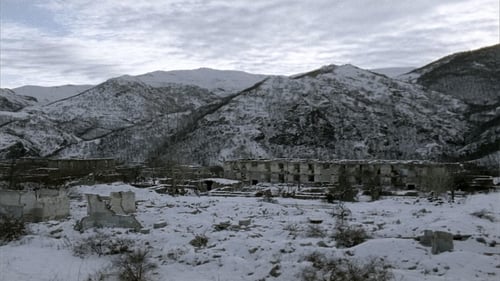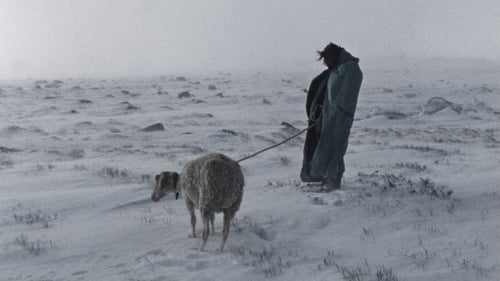
Director
Pierre-Yves Vandeweerd continues his powerful political and poetic body of work with this new film, shot in 16mm, which travels through the regions around Ararat along its “inner lines”, to use the military terminology. These parallel routes are also used by messengers and their carrier pigeons to connect communities scattered by conflict.

Cinematography
Human beings who have experienced such a strong shock that they are no longer even afraid of death (as it often happens to genocide survivors) sometimes fall into what is known as a feeling of timelessness or a “melancholy”. They live somewhat “outside” time, a mode of extra-temporal existence, waiting for the day on which they will be freed from their suffering. It is the people — almost ghosts having survived the conflict in Nagorno-Karabakh between Armenians and Azerbaijani that has lasted for almost twenty years — that the filmmaker shows and listens to in his film. Behind them, behind their wandering bodies, behind their frenzies, is what remains of the collapse of the Soviet Union in Caucasus: ruins, uninhabited spaces, tombs, vestiges of war, trenches where soldiers watch for an invisible enemy.

Writer
Human beings who have experienced such a strong shock that they are no longer even afraid of death (as it often happens to genocide survivors) sometimes fall into what is known as a feeling of timelessness or a “melancholy”. They live somewhat “outside” time, a mode of extra-temporal existence, waiting for the day on which they will be freed from their suffering. It is the people — almost ghosts having survived the conflict in Nagorno-Karabakh between Armenians and Azerbaijani that has lasted for almost twenty years — that the filmmaker shows and listens to in his film. Behind them, behind their wandering bodies, behind their frenzies, is what remains of the collapse of the Soviet Union in Caucasus: ruins, uninhabited spaces, tombs, vestiges of war, trenches where soldiers watch for an invisible enemy.

Director
Human beings who have experienced such a strong shock that they are no longer even afraid of death (as it often happens to genocide survivors) sometimes fall into what is known as a feeling of timelessness or a “melancholy”. They live somewhat “outside” time, a mode of extra-temporal existence, waiting for the day on which they will be freed from their suffering. It is the people — almost ghosts having survived the conflict in Nagorno-Karabakh between Armenians and Azerbaijani that has lasted for almost twenty years — that the filmmaker shows and listens to in his film. Behind them, behind their wandering bodies, behind their frenzies, is what remains of the collapse of the Soviet Union in Caucasus: ruins, uninhabited spaces, tombs, vestiges of war, trenches where soldiers watch for an invisible enemy.

Director
Short film by Pierre-Yves Vandeweerd produced for the 2014 Visions du réel film festival in Switzerland.

Director of Photography
Guided by the sheepbells of a flock and by the evocations of the lost, this film is a voyage through storms; those of the mountains and winter, those of bodies and souls, those which remind us that which nature has not obtained from our reason, obtaining from our madness.

Director
Guided by the sheepbells of a flock and by the evocations of the lost, this film is a voyage through storms; those of the mountains and winter, those of bodies and souls, those which remind us that which nature has not obtained from our reason, obtaining from our madness.

Director of Photography
The simplified black-and-white documentary challenges the viewer to hear the story of the Sahrawi people.

Director
The simplified black-and-white documentary challenges the viewer to hear the story of the Sahrawi people.

Writer
2009 documentary by Pierre-Yves Vandeweerd, set in Belgium, Senegal, the Ardennes and Western Sahara.

Director
2009 documentary by Pierre-Yves Vandeweerd, set in Belgium, Senegal, the Ardennes and Western Sahara.

Cinematography
Le Cercle des noyés is the name given in Mauritania to black political prisoners imprisoned from 1987 in the old colonial fortress of Oualata. This film touches on the fragile process of unveiling memories by one of these former prisoners who remembers his story and that of his companions. In a visual echo, the places of their confinement come one after another denuded from any traces of that past.

Writer
Le Cercle des noyés is the name given in Mauritania to black political prisoners imprisoned from 1987 in the old colonial fortress of Oualata. This film touches on the fragile process of unveiling memories by one of these former prisoners who remembers his story and that of his companions. In a visual echo, the places of their confinement come one after another denuded from any traces of that past.

Director
Le Cercle des noyés is the name given in Mauritania to black political prisoners imprisoned from 1987 in the old colonial fortress of Oualata. This film touches on the fragile process of unveiling memories by one of these former prisoners who remembers his story and that of his companions. In a visual echo, the places of their confinement come one after another denuded from any traces of that past.

Writer
Documentary about the war in South Sudan.

Director
Documentary about the war in South Sudan.

Director
I travelled across Mauritania to find a tree that I saw from my window in Belgium. It wasn't a mythical tree, but rather one that could be anywhere. On my way, I met men and women who shared their perception of this quest and in doing so, in a roundabout way they shared some of their visions of the world and of existence. For some, my tree was the sign from the spirits, of the invisible or a call from light. For others, it was the symbol of a history, a culture or the end of a period in time. For yet others, it was a tree that you see only when you get lost...

Director
Documentary depicting the filmmakers' efforts to find a nomadic Mauritanian family they had filmed six years earlier in order to show them the recorded footage.

Director














